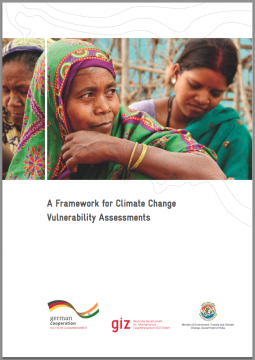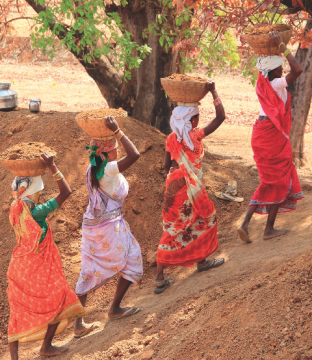A Framework for Climate Change Vulnerability Assessments


‘It used to rain continuously for about 15 days without stopping. This fantastic rain would leave all our lands, homesteads and crops completely saturated. But these continuous rains have stopped happening, which poses big challenges for our agricultural practices.’
-Ramcharan Marco, 65 years Pathadevgaon village, Madhya Pradesh
New GIZ publication on vulnerability assessments
The impacts of global climate change are increasingly being felt around the world. Rising temperatures, changing rainfall patterns, and the melting of glaciers and permafrost soils are affecting ecosystems and human societies in different ways. While climate change is expected to create new opportunities in some parts of the world, it is also expected to cause considerable distress. The extent of the impact depends on the magnitude of climatic changes affecting a particular system (exposure), the characteristics of the system (sensitivity), and the ability of people and ecosystems to deal with the resulting effects (adaptive capacities of the system). These three factors determine the vulnerability of the system.
Assessing vulnerability to climate change is important for defining the risks posed by climate change and provides information for identifying measures to adapt to climate change impacts. It enables practitioners and decision-makers to identify the most vulnerable areas, sectors and social groups. In turn, this means climate change adaptation options targeted at specified contexts can be developed and implemented.
Over the past decades, methods of vulnerability assessment have been developed in a wide range of development-related fields, ranging from natural hazards research, food security research and poverty analysis, to sustainable livelihoods research and related fields. All of these methods have been well documented and discussed. Several conceptual models have been developed to give environmental managers a framework for understanding vulnerability to natural disasters and how to reduce it (for example, Anderson & Woodrow, 1998; Blaikie, et al., 1994; Twigg, 2001). Experiences with these frameworks suggest that vulnerability is a complex subject that has many dimensions (economic, social, political and geographic), which may often have overlapping effects that make it difficult to tease out the precise cause-effect relationship. Consensus has been reached that vulnerability is bound to a specific location and context (Cutter, et al., 2003).
The impacts of and the vulnerabilities to climate change can vary across regions (e.g. global, national, subnational), economic sectors (e.g. agriculture, industry, shipping), social groups (e.g. urban populations, forest dwellers, coastal communities) or types of system considered (e.g. natural, social, economic, socio-ecological). Given these circumstances, the development of any one-size-fits-all solution for assessing vulnerability to climate change is problematic (Hinkel, 2011). This framework therefore provides a way of devising and applying case-specific vulnerability assessment methodologies.
Why this framework?
This framework was prepared to provide decision-makers and adaptation implementers such as (local) government officials, development experts and civil society representatives with a structured approach and a sourcebook for assessing vulnerability to climate change. Furthermore, it provides a selection of methods and tools to assess the different components that contribute to a system’s vulnerability to climate change. Key questions to be addressed are:
- How to plan for a vulnerability assessment?
- Which tools or methods to select to carry out a vulnerability assessment?
- How to carry out a vulnerability assessment?
The reader will first be acquainted with the theoretical background behind the concept of vulnerability. Next, two broad approaches for assessing vulnerability will be introduced: Vulnerability assessments can be carried out either at a local level using participatory methods and tools as well local climate data (bottom-up assessments) or at state, national or global level using large-scale simulation models and statistical methods (top-down assessments).
The introduction to the concept of vulnerability is followed by the main framework consisting of four different stages for assessing a system’s vulnerability to climate change. Each stage in the vulnerability assessment consists of steps that specify which kinds of analyses should be carried out in that stage. Every step contains a set of guiding questions and a list of suggested methods and tools that can be used to answer these questions.
Each stage of the framework is followed by two practical examples of vulnerability assessments carried out in India: A bottom-up vulnerability assessment carried out at the outset of a GIZ supported climate change adaptation project and a top-down vulnerability assessment carried out for the Indian state of Madhya Pradesh as a whole.
Finally, the reader is presented with an extensive yet not exhaustive selection of methods and tools that can be used to assess the components of vulnerability to climate change at different levels.
How this framework was developed
This framework has been prepared as part of the Indo-German development cooperation project ‘Climate Change Adaptation in Rurals Areas of India’ (CCA RAI, www.ccarai.org). CCA RAI commissioned a number of background documents with the objective of preparing a practical approach to climate change vulnerability, risk and impacts assessment.
A consortium consisting of the Global Climate Forum (GCF), Stockholm Environment Institute (SEI) and The Energy and Resources Institute (TERI) worked together to review existing outputs on vulnerability assessment, identify the gaps, and provide recommendations for the development of a framework.
The CCA RAI project team and its project partners used these background documents to develop this practical framework for vulnerability, risk and impact assessment.

Photo credit: GIZ
Report is based on the following documents
Review of methodologies for assessing vulnerability – Report submitted to GIZ in the context of the project Climate Change Adaptation in Rural Areas of India composed by Jochen Hinkel, Global Climate Forum (GCF); Lisa Schipper, Stockholm Environment Institute (SEI); and Sarah Wolf, GCF.
Review of vulnerability assessments in India; Regional context for Vulnerability Assessment; Policy Framework in India to Address Climate Change and Development of Methodology for Climate Change Vulnerability Assessment by G.J. Lingaraj, Himani Upadhyay, Sambita Ghosh, Sneha Balakrishnan, Arabinda Mishra, Suruchi Bhadwal, and Sreeja Nair, all: The Energy and Resources Institute (TERI).
(0) Comments
There is no content